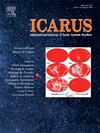The effects of CO2 clouds on the thermal structure of the early Martian atmosphere
IF 3
2区 物理与天体物理
Q2 ASTRONOMY & ASTROPHYSICS
引用次数: 0
Abstract
Characterizing the influence of clouds in the early Martian atmosphere is critical to understanding the nature of the climate. In this paper, we present simple simulations of massive CO2 atmospheres with varying CO2 cloud treatments in order to isolate their effects on the thermal structure of the atmosphere. We use the 3-D NASA Ames Legacy early Mars Global Climate Model with a self-consistent CO2 cloud scheme to simulate 500 mbar, 1 bar, and 2 bar CO2 atmospheres with either no CO2 clouds, radiatively inert CO2 clouds, or radiatively active CO2 clouds. We find that clouds affect the atmosphere in two primary ways, consistent with previous work. First, CO2 cloud condensation releases latent heat and warms temperatures aloft, causing cooling in the lower atmosphere in order to maintain energy balance. Second, CO2 cloud scattering in the visible and infrared leads to competing cooling and warming effects respectively, though ultimately the infrared scattering leads to lower atmosphere warming in our simulations. Overall, these effects lead to significant changes in the thermal structure of these atmospheres. At ∼30 km in altitude, CO2 clouds warm the atmosphere by up to 20 K, 30 K, and 45 K in 500 mbar, 1 bar, and 2 bar atmospheres, respectively. CO2 clouds are ubiquitous in these atmospheres, spanning a large range of latitudes, longitudes, and altitudes. We conclude that CO2 clouds are important to account for in global climate modeling studies of early Mars. Future work should explore potential interactions between CO2 clouds, water ice clouds, and the dust cycle as well as the behavior of CO2 clouds in warmer early Mars scenarios, as they may have the ability to limit greenhouse warming.
二氧化碳云对早期火星大气热结构的影响
描述早期火星大气中云的影响对理解气候的本质至关重要。在本文中,我们提出了具有不同CO2云处理的大量CO2大气的简单模拟,以便分离它们对大气热结构的影响。我们使用3-D NASA Ames Legacy早期火星全球气候模型和自一致的二氧化碳云方案来模拟500毫巴、1巴和2巴的二氧化碳大气,其中包括无二氧化碳云、辐射惰性二氧化碳云或辐射活跃二氧化碳云。我们发现云主要通过两种方式影响大气,这与之前的研究结果一致。首先,二氧化碳云凝结释放潜热,使高空温度升高,导致低层大气冷却,以维持能量平衡。其次,CO2云在可见光和红外波段的散射分别导致了相互竞争的降温和升温效应,尽管在我们的模拟中,红外散射最终导致了低层大气变暖。总的来说,这些影响导致这些大气的热结构发生重大变化。在海拔~ 30公里处,二氧化碳云在500毫巴、1巴和2巴大气压下分别使大气升温20、30和45 K。二氧化碳云在这些大气中无处不在,跨越了很大范围的纬度、经度和高度。我们的结论是,在早期火星的全球气候模型研究中,二氧化碳云是重要的。未来的工作应该探索二氧化碳云、水冰云和尘埃循环之间的潜在相互作用,以及二氧化碳云在温暖的早期火星情景中的行为,因为它们可能有能力限制温室变暖。
本文章由计算机程序翻译,如有差异,请以英文原文为准。
求助全文
约1分钟内获得全文
求助全文
来源期刊

Icarus
地学天文-天文与天体物理
CiteScore
6.30
自引率
18.80%
发文量
356
审稿时长
2-4 weeks
期刊介绍:
Icarus is devoted to the publication of original contributions in the field of Solar System studies. Manuscripts reporting the results of new research - observational, experimental, or theoretical - concerning the astronomy, geology, meteorology, physics, chemistry, biology, and other scientific aspects of our Solar System or extrasolar systems are welcome. The journal generally does not publish papers devoted exclusively to the Sun, the Earth, celestial mechanics, meteoritics, or astrophysics. Icarus does not publish papers that provide "improved" versions of Bode''s law, or other numerical relations, without a sound physical basis. Icarus does not publish meeting announcements or general notices. Reviews, historical papers, and manuscripts describing spacecraft instrumentation may be considered, but only with prior approval of the editor. An entire issue of the journal is occasionally devoted to a single subject, usually arising from a conference on the same topic. The language of publication is English. American or British usage is accepted, but not a mixture of these.
 求助内容:
求助内容: 应助结果提醒方式:
应助结果提醒方式:


